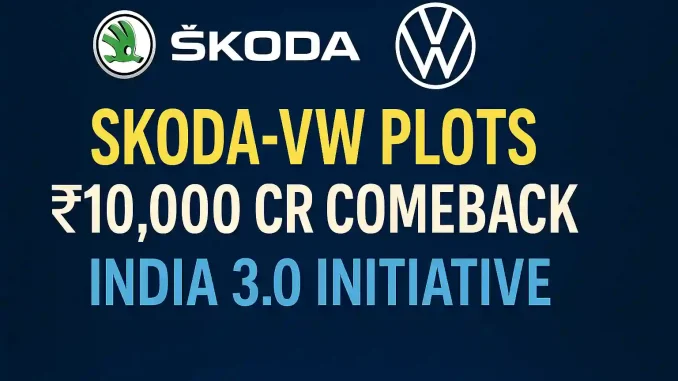
In a bid to re-establish its dominance in one of the world’s fastest-growing automobile markets, the Skoda Auto Volkswagen India Group (SAVWIPL) is setting the stage for a grand comeback with its ambitious India 3.0 strategy. Backed by a massive investment of ₹10,000 crore, this initiative represents the most significant and focused effort the German automotive group has made to revive and expand its footprint in India—a market that has challenged many global automakers over the years.
The Background: Lessons from the Past
Volkswagen entered the Indian market with high expectations, but despite a strong global reputation for engineering and performance, the group struggled to translate its global success into local dominance. A combination of factors—ranging from pricing missteps, limited product portfolios, underwhelming localization levels, and lack of widespread after-sales support—held back the company’s growth.
By 2020, Skoda and Volkswagen had only a modest presence in India, and several other global car brands were either scaling down or exiting the country altogether. However, SAVWIPL saw potential where others saw obstacles. This conviction laid the foundation for India 2.0, an earlier phase that attempted to localize development and manufacture more aggressively.
Building on that, India 3.0 aims to take the initiative to the next level by doubling down on localization, electric mobility, R&D, and a broader product pipeline. The plan is not just to survive, but to thrive in India—an increasingly vital market for future growth.
India 3.0: What It Encompasses
The India 3.0 initiative is not merely a product refresh. It’s a complete reboot of how Skoda-Volkswagen approaches the Indian market.
1. Deep Localization: “Made in India, for India and the World”
At the core of India 3.0 is a renewed focus on 95% localization. This includes designing vehicles specifically for Indian conditions and manufacturing them locally using a high percentage of Indian components. The company has already transformed its operations at the Chakan facility in Pune into a central hub for both domestic and export markets.
This high localization allows the group to control costs, offer competitive pricing, and improve after-sales service—three critical pillars of success in India’s price-sensitive and service-demanding auto industry.
2. MQB-A0-IN Platform: The Backbone of India 3.0
The MQB-A0-IN platform is a localized derivative of the Volkswagen Group’s global MQB platform, tailored specifically for India. Developed jointly by engineers in India and Germany, this modular architecture allows the company to produce a range of vehicles—both Skoda and VW-branded—on the same base, thereby optimizing development time and reducing manufacturing costs.
The Skoda Kushaq and Volkswagen Taigun, the first products of this platform, have already shown promise in terms of safety ratings, features, and consumer reception. More models based on this platform, including sedans and crossovers, are set to follow.
3. ₹10,000 Crore Investment: A Vote of Confidence
The investment—one of the largest by a foreign auto manufacturer in India in recent times—is being deployed across R&D, manufacturing, vendor development, digital transformation, and EV readiness.
This capital injection underscores the Volkswagen Group’s long-term commitment to the Indian market and positions India as one of the key pillars of its global growth strategy.
Electrification and Future Mobility
While the current focus is on internal combustion engine (ICE) vehicles, India 3.0 also prepares the groundwork for an electric vehicle future. With India pushing toward cleaner mobility and setting aggressive EV adoption targets, SAVWIPL is aligning itself with this vision.
Skoda and Volkswagen are exploring the MEB (Modular Electric Drive Matrix) platform for the Indian market. Although the initial launches may involve imported models like the Volkswagen ID.4 and Skoda Enyaq, a locally adapted, affordable EV is on the cards for 2026-27. The group has already begun conducting feasibility studies and evaluating vendor ecosystems to support EV manufacturing domestically.
Exports: Making India a Global Production Hub
A crucial element of the India 3.0 strategy is to transform India into a global export base. Vehicles manufactured in India are already being exported to over 40 countries, including South Africa, Mexico, and the ASEAN region.
Volkswagen and Skoda aim to scale this up significantly by exporting both ICE and EV models. India’s strategic location, combined with a robust supplier base and growing infrastructure, makes it an attractive hub for global exports.
Digital and Dealer Transformation
India 3.0 is also pushing for a revamped digital customer journey and dealership transformation. SAVWIPL has invested in digital retail solutions that enable end-to-end vehicle purchasing and service management online—an essential feature for younger, tech-savvy Indian buyers.
At the same time, the company is expanding and modernizing its dealer network. From 150 dealerships in 2020, Skoda-VW plans to cross 250+ touchpoints by the end of 2025, even in Tier 2 and Tier 3 cities, which are now seeing a surge in car ownership.
Product Pipeline: What’s Next
Under India 3.0, Skoda-Volkswagen is expected to launch multiple new models, including:
- Skoda Kushaq and VW Taigun facelifts with improved features and updated tech
- All-new compact SUV below the Kushaq segment
- Skoda Slavia and VW Virtus updates
- A sub-4m SUV, which would allow them to compete in the largest car segment in India (expected 2026)
- Localized EV offerings, starting with semi-knocked-down kits and eventually full local production
Challenges Ahead
Despite the promise, challenges remain. Competition from homegrown brands like Tata Motors and Mahindra (especially in the EV space), rising input costs, and regulatory uncertainties could create headwinds. Additionally, consumer preferences in India change rapidly, and brand perception still heavily influences buying decisions.
To succeed, SAVWIPL will have to balance premium appeal with value-for-money, a tightrope walk that many European automakers have struggled with in India.
Leave a Reply